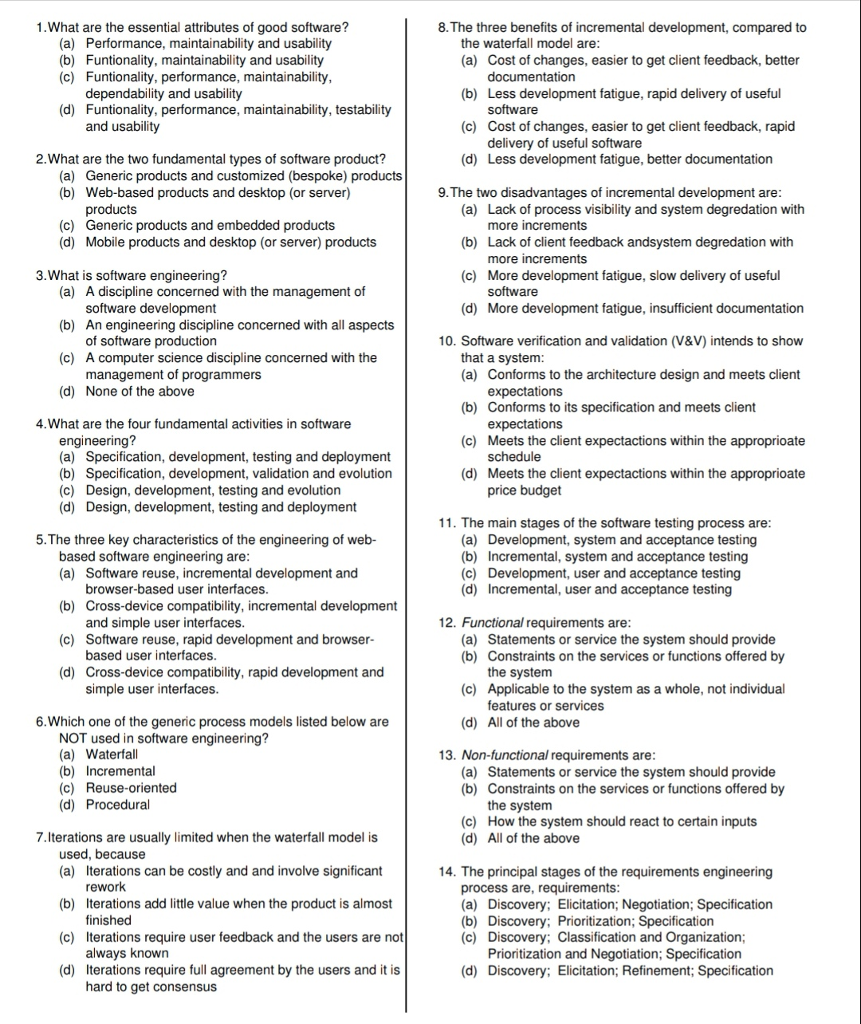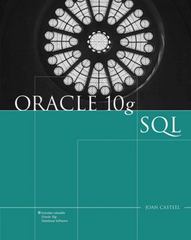
1.What are the essential attributes of good software? 8.The three benefits of incremental development, compared to (a) Performance, maintainability and usability (b) Funtionality, maintainability and usability (c) Funtionality, performance, maintainability, the waterfall model are (a) Cost of changes, easier to get client feedback, better (b) Less development fatigue, rapid delivery of useful (c) Cost of changes, easier to get client feedback, rapid (d) Less development fatigue, better documentation documentation dependability and usability (d) Funtionality, performance, maintainability, testability are and usability delivery of useful software 2.What are the two fundamental types of software product? (a) Generic products and customized (bespoke) products (b) Web-based products and desktop (or server) 9.The two disadvantages of incremental development are products (a) Lack of process visibility and system degredation with (b) Lack of client feedback andsystem degredation with (c) More development fatigue, slow delivery of useful (d) More development fatigue, insufficient documentation (c) Generic products and embedded products (d) Mobile products and desktop (or server) products more increments more increments software 3.What is software engineering? (a) (b) (c) (d) A discipline concerned with the management of software development An engineering discipline concerned with all aspects of software production A computer science discipline concerned with the management of programmers None of the above 10. Software verification and validation (V&V) intends to show that a system (a) Conforms to the architecture design and meets client (b) Conforms to its specification and meets client (c) Meets the client expectactions within the approprioate (d) Meets the client expectactions within the approprioate expectations 4. What are the four fundamental activities in software expectations engineering? (a) Specification, development, testing and deployment (b) Specification, development, validation and evolution (c) Design, development, testing and evolution (d) Design, development, testing and deployment Ul 11. The main stages of the software testing process are: 5.The three key characteristics of the engineering of web- (a) Development, system and acceptance testing (b) Incremental, system and acceptance testing (c) Development, user and acceptance testing (d) Incremental, user and acceptance testing based software engineering are (a) Software reuse, incremental development and (b) Cross-device compatibility, incremental development (c) Software reuse, rapid development and browser- (d) Cross-device compatibility, rapid development and browser-based user interfaces and simple user interfaces. based user interfaces simple user interfaces. 12. Functional requirements are (a) Statements or service the system should provide Constraints on the services or functions offered by (b) (c) (d) Applicable to the system as a whole, not individual features or services All of the above 6.Which one of the generic process models listed below are NOT used in software engineering? (a) Waterfall (b) Incremental (c) Reuse-oriented (d) Procedural 13. Non-functional requirements are (a) Statements or service the system should provide (b) Constraints on the services or functions offered by the system (c) How the system should react to certain inputs (d) All of the above 7.lterations are usually limited when the waterfall model is used, because (a) Iterations can be costly and and involve significant (b) Iterations add little value when the product is almost (c) Iterations require user feedback and the users are not (d) Iterations require full agreement by the users and it is 14. The principal stages of the requirements engineering process are, requirements (a) Discovery; Elicitation; Negotiation; Specification (b) Discovery; Prioritization; Specification (c) Discovery; Classification and Organization rework finished Prioritization and Negotiation; Specification (d) Discovery; Elicitation; Refinement; Specification hard to get consensus







